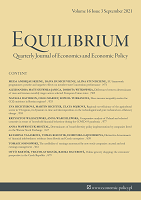Differences between determinants of men and women monthly wages across fourteen European Union states
Differences between determinants of men and women monthly wages across fourteen European Union states
Author(s): Aleksandra Matuszewska-Janica, Dorota WitkowskaSubject(s): Gender Studies, Labor relations, EU-Approach / EU-Accession / EU-Development, Socio-Economic Research
Published by: Instytut Badań Gospodarczych
Keywords: labour market; wages; wages determinants; differences in men and women wage determinants; ordered logit model;
Summary/Abstract: Research background: There is a broad discussion in the literature on the situation of men and women in the labour market, especially about the differences in their remuneration. Due to the fact that females constitute a slightly different group of employees, certain factors have different impacts on the level of their remuneration in comparison to male employees. Hence, the question arises which factors cause these differences and how large the dissimilarities are. Purpose of the article: The aim of the presented study is to diagnose and evaluate differences in the impact of designated determinants on the level of monthly wages of women and men in selected European Union member states. The novelty of our approach consists in both comparison of the intensity of influence examined factors to men?s and women?s earnings, and a global approach to the remuneration of male and female employees. Methods: Due to the nature of the dependent variable (remuneration decile, which is a variable measured on an ordinal scale), the ordered logit model is applied in the analysis. The data comes from the Eurostat?s Labour Force Survey. Findings & value added: Presented results indicate that many factors have significantly different intensity of impact on the level of men and women wages. However, significant differences between parameters estimated for both genders are visible for the group of family variables the most often, then for variables describing the condition of work, the human capital variables, and characteristics of the workplace. This paper adds to the empirical literature a new approach to measure the intensity of factors influencing men and women wages. In addition, our investigation is a cross-country analysis.
Journal: Equilibrium. Quarterly Journal of Economics and Economic Policy
- Issue Year: 16/2021
- Issue No: 3
- Page Range: 503-531
- Page Count: 29
- Language: English

